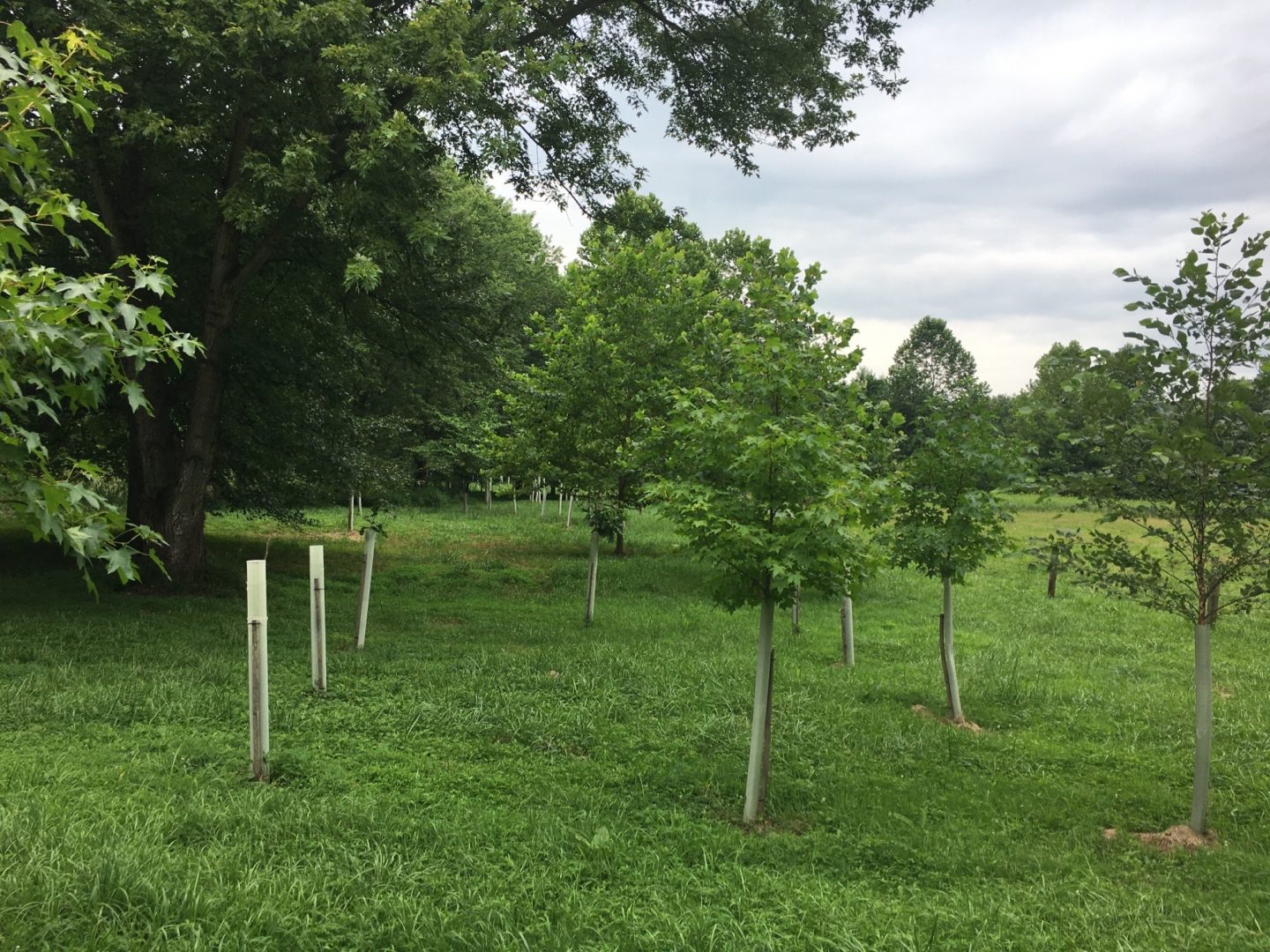
The newest seedlings on Arthur de Leo’s farm. Hidden beyond the older trees is Buck Run, the creek where de Leo planted his first stream buffers. (Courtesy of Arthur de Leo)

The newest seedlings on Arthur de Leo’s farm. Hidden beyond the older trees is Buck Run, the creek where de Leo planted his first stream buffers. (Courtesy of Arthur de Leo)

The newest seedlings on Arthur de Leo’s farm. Hidden beyond the older trees is Buck Run, the creek where de Leo planted his first stream buffers. (Courtesy of Arthur de Leo)
Worried about water quality in your stream? Plant a tree next to it, says the Pennsylvania Department of Conservation and Natural Resources, or DNCR.
The DCNR recently announced a new stream buffer program, urging 10,000 Pennsylvania landowners who live along the state’s streams, creeks, and rivers to plant native trees near the water’s edge.
The term “stream buffers” may sound new, but the concept isn’t — it applies to any trees and shrubs that are deliberately planted along a waterway. They provide nutrients for native insects and fish to flourish and slow the spread of other invasive plant species. Their roots also stabilize the bank, reduce soil erosion, and help to filter chemical fertilizers and other pollutants that would otherwise go directly into the water.
Why is the state encouraging landowners to plant them now?
“The DCNR has made a more concerted effort recently because of the efforts to clean up the Chesapeake Bay, as well as all of the surrounding watershed,” said Teddi Stark, who manages both the riparian buffer and watershed forestry program for the department.
“It’s not necessarily super common knowledge that trees are really good for streams,” she added, “but they’re what form the basis of the food chain for stream ecosystems. They intercept pollution, they prevent erosion… [trees are] very multifaceted, and very essential to stream health.”
More importantly, planting stream buffers is an easily-implemented strategy — something that everyone and anyone living near a waterway can do.
“In the past, there’s been a lot of pressure on farmers in Pennsylvania to add more environmental practices to their farms,” Stark said. “But anyone who owns a stream can help improve their own properties, and help improve the water quality for everyone downstream.”
Arthur de Leo, 80, has been fascinated by growing things ever since he was a boy in Northeast Philadelphia, planting peach stones and blue flags in his family’s tiny rowhouse backyard. He’s been living on his own farm in Chester County for 35 years; over time, he’s earned the friendly title of “buffer enthusiast.”
It started in 1991, with a streamside buffer grant like the DCNR’s and 800 seedlings. He and a friend planted the little trees along the banks of Buck Run, which runs into Brandywine Creek and then into the Christina and Delaware rivers. After that, he found himself constantly buying trees — machine-damaged trees shipped from nurseries, maple saplings off the side of the road, beech seedlings dug up from a friend’s property. When he and his wife bought their nearly 25-acre farm in 1985, there were only 20 trees on the land. Now, he estimates, there are easily eight to ten thousand.
“I love trees because they’re so magical,” he said, rattling off a list of native species: maple, sycamore, sweetgum, oak. “When you plant one, you’re protecting the climate. For years — well, it’s a lifetime of work. I’m trying to leave a legacy besides trash.”
For some farmers and landowners, concerns about attracting insects or wild animals outweigh the potential advantages of streamside buffers, but weed control and early maintenance usually mitigate pest problems, according to state instructions. Depending on the landowner’s location in the watershed, they, like de Leo, may note visible changes related to the streamside buffers: cleaner, fresher water, less sedimentation, and wildlife returning to the area.
If cost or planting logistics are a barrier, the DCNR has both funding and free technical assistance available. The department committed $1.5 million to streamside buffer plantings this year, and recently launched a webpage with information and contact details for potentially interested landowners. Residents in Adams, Franklin, Huntingdon, Lancaster, and York counties have already received flyers by mail encouraging them to consider planting native trees and shrubs on their property.
So far, Stark said, the majority of responses have been positive. She’s hopeful more will follow.
“Most people plant gardens by totalitarianism: they don’t want mess, they don’t want weeds… we try to get people to plant buffers and native things, but it’s a hard sell, because everybody wants it neat,” de Leo said. “The funny thing is that once you start planting this stuff, you have the urge to keep the birds and the bugs.”
He and his wife live on the farm with three donkeys, one peacock, and a cat named Alice May — there’s plenty of acreage for other creatures, too. “If you come out to the farm at dusk, the fireflies are out, the bats are out, the barn swallows are out. It’s all very romantic.”
Tonight, he’ll watch the fireflies. Tomorrow morning, he’ll get up, sit on the porch, have a cup of tea with Alice May, “and just see what there is to do next — another day in paradise.”
WHYY is the leading public media station serving the Philadelphia region, including Delaware, South Jersey and Pennsylvania. This story originally appeared on WHYY.org.
The days of journalism’s one-way street of simply producing stories for the public have long been over. Now, it’s time to find better ways to interact with you and ensure we meet your high standards of what a credible media organization should be.